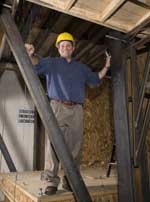The Research Angle: CSU Leads Five-University Seismic Project to Raise the Height of Wood Construction
 |
|
John van de Lindt stands on a table capable of shaking a wood-frame structure to its foundation.
|
The National Science Foundation estimates that more than 75 million U.S. citizens in 39 states live in areas at risk for earthquake devastation. Single-family homes in North America are primarily constructed of wood because of its energy-absorbing properties and demonstrated ability to withstand the effects of wind, major storms and seismic disturbances.
In recent years, however, low-rise wood-frame buildings have sustained significant structural and non-structural damage from earthquakes. The January 1994 Northridge Earthquake near Los Angeles was the most damaging in the U.S. since the San Francisco Earthquake in 1906.
Past research on load paths in woodframe construction during earthquake shaking is limited. Colorado State is heading a new study that is the first step in moving toward performance-based design for wood-frame structures of all sizes. The four-year project is funded by the National Science Foundation as part of the Network for Earthquake Engineering Simulation (NEES).
NEESWood is a consortium of researchers led by John van de Lindt, associate professor of civil engineering at Colorado State. Co-principal investigators are Rachel Davidson (Cornell University), Andre Filiatrault (State University of New York at Buffalo), David Rosowsky (Texas A&M University) and Michael Symans (Rensselaer Polytechnic Institute).
The NEESWood project team is developing a new design philosophy for mid-rise wood-frame construction in regions of moderate to high seismicity. Full-scale testing of a two-story wood-frame structure is ongoing at SUNY-Buffalo. Testing on a one-story woodframe model was completed at Colorado State University's structures laboratory last summer. The NEESWood two-story test is the largest full-scale three-dimensional shake table test ever performed in the U.S. and the largest wood structure test ever performed in the world. The results will serve as a benchmark for both wood-frame performance and nonlinear numerical models for seismic analysis of wood-frame structures.
Initially simulating the effects of a major earthquake on a 160-square-foot, one-story building on a "shake table" at Colorado State, van de Lindt and his five-university team will progress to seismic analysis and testing of taller buildings at participating institutions before concluding their tests on a mid-rise (six to seven story) multi-family residential wood-frame apartment building in Miki City, Japan. Collaborations between NEES and Japan's National Institute for Earth Science and Disaster Prevention E-Defense Project will serve as a basis for a globally seamless network for earthquake engineering.